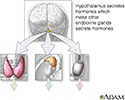Virilization
Virilization is a condition in which a female develops characteristics associated with male hormones (androgens), or when a newborn has characteristics of male hormone exposure at birth.
Virilization may be caused by:
- Excess testosterone production
- Use of anabolic steroids (used for performance-enhancement or other purposes)
In newborn boys or girls, the condition may be caused by:
- Certain medicines taken by the mother during pregnancy
- Congenital adrenal hyperplasia in the baby or the mother
- Other medical conditions in the mother (such as tumors of the ovaries or adrenal glands that release male hormones)
In girls who are going through puberty, the condition may be caused by:
- Polycystic ovary syndrome
- Certain medicines, or anabolic steroids
- Congenital adrenal hyperplasia
- Tumors of the ovaries, or adrenal glands that release male hormones (androgens)
In adult women, the condition may be caused by:
- Certain medicines, or anabolic steroids
- Tumors of the ovaries or adrenal glands that release male hormones
Signs of virilization in a female often depend on the level of testosterone in the body.
Low level (common):
- Thick, dark facial hair in the beard or mustache area
- Increase in body hair
- Oily skin or acne
- Irregular menstrual periods
Moderate level (uncommon):
- Male-pattern baldness
- Loss of female fat distribution
- Decreased breast size
High level (rare):
- Enlargement of the clitoris
- Deepening of the voice
- Male muscle pattern
Tests may include:
- Blood tests to detect excess testosterone or other androgen hormones in females
- CT scan, MRI, or ultrasound to rule out tumors of the ovaries and adrenal glands
If virilization is caused by exposure to androgens (male hormones) in female adults, many of the symptoms go away when the hormones are stopped. However, deepening of the voice is a permanent effect of exposure to androgens.
References
Styne DM. Physiology and disorders of puberty. In: Melmed S, Auchus RJ, Goldfine AB, Koenig RJ, Rosen CJ, eds. Williams Textbook of Endocrinology. 14th ed. Philadelphia, PA: Elsevier; 2020:chap 26.
White PC. Sexual development and identity. In: Goldman L, Schafer AI, eds. Goldman-Cecil Medicine. 26th ed. Philadelphia, PA: Elsevier; 2020:chap 220.
Review Date: 4/27/2023





